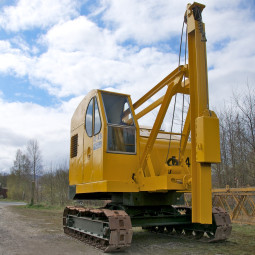 A pile driver is simply a mechanical device which is used to force ‘piles’ or heavy beams, composed of wood, steel or reinforced concrete, down into the earth when deep foundations are required. The action of driving piles causes the soil around them to be displaced and compressed around the sides of the piles thus increasing their load-bearing capability.
A pile driver is simply a mechanical device which is used to force ‘piles’ or heavy beams, composed of wood, steel or reinforced concrete, down into the earth when deep foundations are required. The action of driving piles causes the soil around them to be displaced and compressed around the sides of the piles thus increasing their load-bearing capability.
In the past piles were driven into the ground by a large heavy object which was held in a frame and suspended above the pile. Once released, it relied on gravity to do the job, smashing onto the pile and driving it into the ground before being winched back up to the top of the frame to begin its journey once again. However as the years passed and technology evolved, pile drivers were mechanised using various methods for raising the weight and driving the pile.
Diesel hammers
Diesel hammers are the most commonly used pile drivers throughout the world as they not only have a straightforward design, but they are also relatively inexpensive to run. Based on an original 1930’s design developed by the German company Delmag, they work just like a two-stroke engine by utilising a cylinder and piston system to compress air and fuel on top of an impact block (the anvil), which causes them to ignite and set off an explosion. The force of this explosion helps to drive the pile into the ground while returning the piston (ram) back up the cylinder to the top of its housing, ready to begin the whole process again. While diesel pile drivers are popular, they are noisy and release a significant amount of diesel exhaust fumes into the atmosphere.
Hydraulic hammers
More modern than diesel pile drivers, the cylinders of hydraulic hammers are filled with hydraulic fluid rather than compressed air and diesel, with this fluid being used to generate the driving force. They are generally the preferred system as they lessen the effects of vibration on both the pile and the surrounding areas, which is particularly important if the pile driving site is surrounded by other structures which could potentially be affected. Hydraulic pile drivers are also significantly quieter than their diesel or vibratory counterparts, typically falling under the 70 decibel range.
Vibratory hammers
In contrast to both diesel and hydraulic pile drivers, vibratory hammers utilise a series of counter-rotating hydraulically powered weights which have been designed to ‘cancel out’ the horizontal vibrations while transmitting the vertical vibrations directly into the pile below and hammering it into the ground. This kind of driver requires less vertical piston clearance which means that they are ideal for locations where space is limited, for example if it’s necessary to add extra supports to something already in situ, such as a bridge. Used to both drive and extract piles, a variety of hammers can be fitted to the pile driver according to the hardness of the ground being penetrated, ranging from those which vibrate 1200 times per minute to those which vibrate at double that speed.
James developed an interest in all kinds of construction methods as a by-product of developing his own home. He writes for Piling Equipment Ltd who supply pile drivers to the construction industry.
